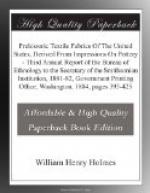[Illustration: Fig. 82.—From
fragment of a large salt vessel,
Saline River, Illinois.]
Another example from the same locality is shown in Fig. 83. This is similar to that shown in the lower figure of Plate XXXIX. It is very neatly woven of evenly spun and well-twisted thread. The double series is widely spaced as shown in the drawing.
[Illustration: Fig. 83.—From a salt vessel, Saline River, Illinois.]
The very interesting specimen illustrated in Fig. 84 was obtained from a small fragment of pottery found in Fort Ripley County, Missouri. The combination of the two series of threads or strands clearly indicates the type of fabric under consideration, the twisted cords of the warp being placed very far apart. The remarkable feature of this example is the character of the woof, which seems to be a broad braid formed by plaiting three strands of untwisted fiber, probably bast. All the details are shown in the most satisfactory manner in the clay cast.
[Illustration: Fig. 84.—From ancient pottery, Missouri.]
The open character of the web in this specimen assists very much, in explaining the structure of tightly-woven examples such as that shown in Fig. 85, in which the cross cords are so closely placed that the broad bands of the opposing series are completely hidden.
[Illustration: Fig. 85.—From ancient pottery, Tennessee.]
I have made the drawing to show fillets of fiber appearing at the ends. These do not appear in the impression. It is highly probable, however, that these fillets are plaited bands, as in the preceding example. They are wide and flat, giving somewhat the effect of basket-work of splints or of rushes. This specimen was obtained in Carter County, Tennessee.
We have a few pieces of this variety of fabric which
have been preserved by contact with the salts of copper.
Professor Farquharson describes an example from a
mound on the banks of the Mississippi River, near
the city of Davenport. It had been wrapped about
a copper implement resembling a celt, and was at the
time of its recovery in a very perfect state of preservation.
In describing this cloth Mr. Farquharson says that
“the warp is composed of four cords,
that is, of two double and
twisted cords, and the woof of one
such doubled and twisted cord
which passes between the two parts of
the warp; the latter being
twisted at each change, allowing the cords
to be brought close
together so as to cover the woof almost
entirely.”
His illustration is somewhat erroneous, the artist
not having had quite a clear understanding of the
combination of threads. This cloth has a general
resemblance to ordinary coffee-sacking. In Fig.
86 I give an illustration of this fabric derived from
the opposite side of the celt.
[Illustration: Fig. 86.—Fabric from a copper celt, Iowa.]
Although I am not quite positive, it is my opinion, after having examined the specimen carefully, that the body of the cloth belongs to my first group and that the border only is of the second group. My section and drawing give a clear idea of the construction of this fabric. A finely-preserved bit of cloth belonging to the group under consideration was recently found fixed to the surface of a copper image from one of the Etowah mounds in Georgia.




